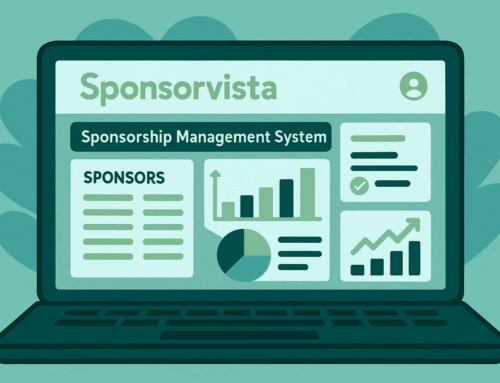What is Sponsorship Management?

Sponsorship Management for Sports Clubs, Associations, and Organizations: What is Sponsorship Management and how Do You Approach it?
Introduction
Sponsorship is vital for many sports clubs. Additional income from sponsors helps keep membership fees affordable and enables the association to achieve its ambitions. However, we often see that, especially with amateur clubs, sponsorship often amounts to a board along the field or a logo on a shirt, arranged through a friendly entrepreneur. How do you ensure truly effective sponsorship management – more than just putting up a sponsor board – so that your club benefits sustainably? In this article, we explain the meaning of sponsorship management, why it is so important, and share practical tips to get more value from sponsors.
What is Sponsorship Management?
We define sponsorship management as the structured acquisition, recording, and maintenance of sponsor relationships for your association. It encompasses all steps from identifying potential sponsors, approaching and securing them (sponsor acquisition), to administering agreements, invoices, and maintaining the relationship. In essence, it is a form of relationship management focused on sponsors. Modern sponsorship management tools, for example, offer possibilities to maintain sponsor profiles (with contact details, agreements, contributions, contract duration, etc.) and centrally manage all sponsor information. By properly organizing sponsorship management, you prevent sponsor agreements from becoming fragmented or forgotten and ensure continuity in your sponsorship income.
Sponsorship vs. donation: With sponsorship, the sponsor always receives something in return for their contribution – for example, name recognition or advertising – unlike a pure gift. A sponsorship deal is therefore a business agreement in which the association provides a reciprocal service, such as exposure in the club magazine, on social media, or around the sports field. Sponsorship management is about ensuring these agreements run optimally, both administratively and in terms of the relationship.
The Importance of Sponsorship for Clubs
For sports associations, sponsorship income is often indispensable. Membership fees alone are usually not enough to cover all costs, especially now that expenses for accommodation, energy, and materials continue to rise. Sponsorship offers a solution: companies or local entrepreneurs contribute financially in exchange for publicity, so the club has additional resources. For example, the association can keep membership fees affordable or even hire professionals to lighten the burden of volunteer work.
It is also interesting for businesses to sponsor a local sports club. Clubs represent a clear target community (e.g., all members and their families) that is attractive to entrepreneurs. Sponsoring an association is also a relatively affordable way of local marketing compared to advertising in newspapers or on the radio. In other words: a win-win for both club and sponsor.
Common Forms of Sponsorship Exposure
In amateur sports, when we think of sponsorship, we quickly think of advertising boards along the field – and that is indeed the most common form. A sponsor then pays an annual amount and receives a board with their company logo in a highly visible spot at the facility. On average, clubs ask for a few hundred euros per year for such a sponsor board, but in reality, a well-placed board is certainly worth $750 per year. Shirt sponsorship is also popular: companies pay for their logo on match kits, often in exchange for covering the cost of the shirts themselves. In addition, there are many other possibilities: consider a sponsor banner on the club website, advertisements in the club magazine, or a mention on social media.
Sponsorship does not always have to be monetary. In-kind sponsorship also occurs, for example, a local printer who prints the club magazine for free, or an administrative office that handles the bookkeeping for a few hours a month. The club receives value in services/goods, and the sponsor receives promotion in return. Although monetary sponsorship is most common, such creative in-kind agreements can also be very valuable for an association.
Tip: Reward new sponsors with extra visibility. Hang a new sponsor board in a prominent place for the first few weeks and take a photo of it to send to the sponsor. This way, the sponsor immediately feels appreciated and receives more attention.
Challenges in Sponsorship Management
However, sponsorship management in an association is not without obstacles. This task often rests on the shoulders of a few volunteers who have to do it alongside their busy lives. Some common challenges:
- Limited network: Many clubs primarily acquire sponsors from their own circle of parents and acquaintances. Finding new sponsors outside that network is difficult.
- Limited manpower and time: The number of volunteers actively recruiting sponsors is often small – or people are hesitant to approach companies.
- Fragmented administration: Without a proper system, sponsor data ends up in separate Excel files or emails.
- Higher sponsor expectations: Companies are approaching sponsorship more professionally and expect a greater return on their contribution than before.
An active sponsorship committee is therefore not a luxury but a necessity. Fortunately, there are solutions to address these challenges, from smart strategies to digital tools, so that even a club with few volunteers can effectively manage sponsorships.
Why Do Companies Sponsor Sports Clubs?
The reasons vary per sponsor, but broadly there are four categories:
- Personal connection
- Commercial interest
- Corporate Social Responsibility (CSR)
- Other motives, such as labor market or local involvement
By understanding a potential sponsor’s motivation, you can tailor your offer accordingly.
Practical Tips for Effective Sponsorship Management
- Think from the sponsor’s perspective
- Make a concrete proposal (for example: $750 per board)
- Keep administration and agreements in order
- Work with sponsorship packages (but remain flexible)
- Communicate regularly and professionally
- Plan renewals and new acquisition in a timely manner
- Utilize your network and look beyond it
- Ensure a professional appearance
Modern Tools for Sponsorship Management
Digital tools can make sponsorship management much more efficient. Consider:
- Automation of invoices and contracts
- Reminders and task lists
- Dashboard with overview of sponsorship income
- Mailing tools for sponsor updates
- Access to new sponsor candidates
SponsorVista ( SponsorVista ) offers all these features in one platform, specifically designed for sports associations.
Conclusion
Good sponsorship management is an investment that pays off handsomely. With the right approach, tools, and mindset, your club can consistently gain more value from your sponsors and become more attractive for new collaborations.
Sources:
- KNVB: https://www.knvb.nl
- SponsorVista: https://sponsorvista.com
- DoubleSmart: https://www.doublesmart.nl




